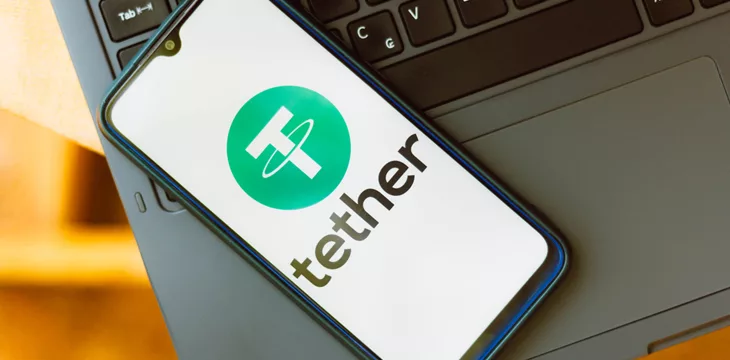|
Getting your Trinity Audio player ready...
|
The Tether (USDT) stablecoin claims to have closed out 2023 with a nearly $3 billion quarterly profit, according to its latest not-an-audit attestation.
On Wednesday, Tether issued its Q4 2023 ‘consolidated reserves report,’ aka the ‘reasonable assurance engagement’ performed by BDO Italia on the one-day (December 31) financial snapshot that Tether allowed BDO to peruse.
As always, Tether noted that it prepared its reserves report “using the recognition and measurement principles” of International Financial Reporting Standards (IFRS) without making sufficient disclosures to actually comply with IFRS. (It’s the thought that counts, right?)
But enough disclaimers, here are the claims. Tether claims to have had total assets of $97 billion versus $91.6 billion worth of issued USDT as of December 31. That allegedly leaves Tether with $5.4 billion in excess reserves, including most of the $2.85 billion in “record-breaking net profit” Tether earned in Q4. (As some have pointed out, that’s $844 million more than Goldman Sachs made last quarter.)
Tether claims the ‘Cash & Cash Equivalent & Other Short-Term Deposits’ segment of its reserves stood at over $82 billion on December 31, roughly $6 billion higher than at the end of Q3. Of this sum, short-term U.S. Treasury Bills allegedly accounted for nearly $63.1 billion, up from Q3’s $56.6 billion.
Tether further claims its total T-bill ‘exposure’ is actually $80.3 billion if you add in overnight reverse repurchase agreements secured by T-bills and money market funds invested in them.
The whereabouts of Tether’s alleged mountain of T-bills remained a closely guarded secret until last December when Cantor Fitzgerald CEO Howard Lutnick went on CBNC and abruptly declared (without anyone asking) that “I hold [Tether’s] treasuries … and they have a lot of treasuries.”
Lutnick followed this revelation with an appearance on Bloomberg TV from the recent World Economic Forum in Davos, during which he said: “I manage many, many of [Tether’s] assets … from what we’ve seen, and we did a lot of work, they have the money they say they have…I’ve seen a whole lot, and the firm has seen a whole lot, and they have the money.”
That’s right, folks. A sector that claims to embody the mantra of ‘don’t trust: verify’ is instead trusting an individual’s claims of having totally seen “a whole lot” of something or other. Which apparently is sufficient to justify the entire financial underpinnings of this opaque business we call ‘crypto.’
With respect to Lutnick, this is like him claiming he has an aurora borealis in his kitchen and then refusing to show us. Lutnick may well be correct in his claims, but until Tether submits to a full and truly independent third-party audit, skepticism regarding Tether’s ability to print USDT out of thin air isn’t going anywhere.
Neither a borrower nor a lender be
The high-interest rates generated by T-bills allegedly accounted for $4 billion of the total $6.2 billion in ‘net profit’ Tether claims to have earned in 2023. Tether CEO Paolo Ardoino claims this profit “showcases our financial strength,” but as always with Tether, the devil’s in the hard-to-verify details.
The ‘secured loans’ segment of Tether’s reserves underwent a minor reduction from Q3 to Q4, dipping by $364 million to $4.8 billion. Tether once promised to eliminate these controversial markers entirely from its balance sheet by the end of 2022, but somewhere along the way, this either proved impossible or the company had a distinct change of heart.
Thanks to its alleged profits, Tether has now found a way to brush these loans under the rug. Tether claims that its loans are “fully covered by the undistributed accumulated profits known as excess reserves,” so no one needs to concern themselves with their existence. Impressed by its own fiscal legerdemain, Tether congratulated itself on having “achieved its goal of removing the risk of secured loans from the token reserves,” which, it must be said, isn’t what they promised.
Much has been made about a Tether spokesperson’s previous claims that these loans were issued to “clients with whom we have cultivated longstanding relationships” and were intended “to prevent any significant depletion of our customers’ liquidity or the need for them to sell their collateral at potentially unfavorable prices, which could result in losses.
Ardoino was apparently so rattled by these disclosures at the time that he denied the person who uttered them ever worked for Tether. He said this despite having said nothing about this same person’s status following previous quotes on Tether’s behalf on multiple occasions in major media outlets.
When BDO Italia took over the job of providing Tether’s quarterly attestations, it excised a phrase that Tether’s former attesters, MHA Cayman, used in discussing Tether’s loans. Specifically, none of Tether’s loans were made to “affiliated entities,” like, say, the
Bitfinex exchange, with which Tether shares ownership and with which Tether has been caught sharing sizable cash deposits at crucial moments.
Buying BTC, not buying USDC
Tether’s outstanding loan balance may not have budged much, but the fiat value of Tether’s alleged stash of BTC tokens rose by $1.16 billion to $2.8 billion between October 1 and December 31. Tether began buying BTC in earnest last spring, promising to “regularly allocate up to 15% of its net realized operating profits” to buy the tokens. (Forgetting ‘digital gold’ a moment, Tether’s supply of physical gold bars rose by $350 million to $3.5 billion in Q4. No, you can’t see those either.)
Some believe they’ve worked out the mechanics of Tether’s ‘buy BTC’ strategy. It involves Tether printing USDT out of thin air, using that USDT to acquire BTC, calling the newly acquired BTC collateral, then using that BTC to justify the issuance of new USDT, and then repeating the whole process from the start. (This ‘be your own bank’ stuff is amazing!)
It’s also effective. The amount of issued USDT currently stands at $96.2 billion, a roughly $13 billion increase in just four months. During that period, BTC’s fiat price rose from $27,000 to nearly $47,000 before slipping back to its current price of around $42,000.
Meanwhile, the market cap of Tether’s biggest stablecoin rival, Circle’s USDC, failed to experience a similar surge in market cap. In the period, USDT added $13 billion, and USDC added … $300,000.
There may be some theoretically valid reasons for this discrepancy, including USDC’s confidence-shaking $3.3 billion reserves hiccup when Silicon Valley Bank went under last spring. And yes, Circle also releases attestations of its reserves rather than audits.
However, Circle is more upfront about its reserves, including providing CUSIP numbers for its T-bills, while the only other asset they list is cash. That’s a far cry from Tether’s hodgepodge of T-bills, gold, Beanie Babies, corporate bonds, and nearly $4 billion in undefined ‘other investments.’
And unlike Tether, Circle has ready access to U.S. banking, which is why so many USDT holders convert to USDC before cashing out to fiat. Meanwhile, Tether has been reduced to engaging in bank fraud due to U.S. banks fearing regulatory blowback from any association with the scrutiny-averse entity.
But perhaps avoiding the scrutiny of U.S. banking watchdogs is the whole point of Tether’s appeal, at least for the human traffickers, money launderers, and terrorists who’ve been publicly linked with the stablecoin. No less an authority than the United Nations Office on Drugs and Crime (UNODC) recently issued a report detailing the pivotal role that USDT plays in “the banking architecture used by organized crime.”
Tether responded to the UN report by declaring it remains “steadfast in promoting transparency and accountability in digital currencies.” Those lofty sentiments would ring a lot truer if Tether’s transparency and accountability was capable of producing One. Damn. Audit.
Follow CoinGeek’s Crypto Crime Cartel series, which delves into the stream of groups—from BitMEX to Binance, Bitcoin.com, Blockstream, ShapeShift, Coinbase, Ripple, Ethereum,
FTX and Tether—who have co-opted the digital asset revolution and turned the industry into a minefield for naïve (and even experienced) players in the market.

 12-10-2025
12-10-2025 





